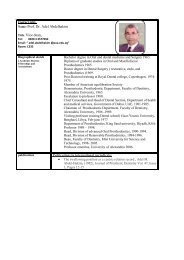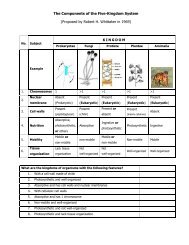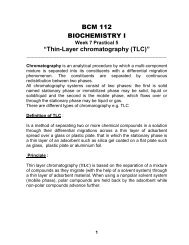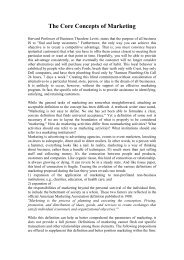E-tourism in England a strategy .pdf
E-tourism in England a strategy .pdf
E-tourism in England a strategy .pdf
You also want an ePaper? Increase the reach of your titles
YUMPU automatically turns print PDFs into web optimized ePapers that Google loves.
likely to reach saturation po<strong>in</strong>t or maturity, but some 39% of all UK households are<br />
now able to access the Internet from home.<br />
• Increas<strong>in</strong>g proportions of Internet users are buy<strong>in</strong>g onl<strong>in</strong>e, with a predicted 32% of UK<br />
users forecast to use the Internet for retail transactions over the next five years.<br />
• Travel and <strong>tourism</strong> will ga<strong>in</strong> an <strong>in</strong>creas<strong>in</strong>gly large share of the global onl<strong>in</strong>e commerce<br />
market, from an estimated 30% today to around 50% <strong>in</strong> the future.<br />
• The dom<strong>in</strong>ance of air travel has reduced from more than 80% four years ago to about<br />
60% now, whilst hotels’ share correspond<strong>in</strong>gly has doubled to nearly 25%.<br />
Accommodation, car hire and other ground-based products will ga<strong>in</strong> a larger share of<br />
global onl<strong>in</strong>e commerce <strong>in</strong> travel and <strong>tourism</strong>.<br />
• User profiles broadly match the target markets of many <strong>tourism</strong> organisations – Internet<br />
users tend to be relatively wealthy, well educated, and <strong>in</strong>terested <strong>in</strong> <strong>in</strong>dependent travel.<br />
Data from the Office for National Statistics about Internet usage concludes that:<br />
There is a consistently high (43-52%) level of Internet usage amongst all age groups up to<br />
the age of 55. Older people have a lower (but certa<strong>in</strong>ly not <strong>in</strong>significant) level of usage –<br />
almost one third of those up to 64 and one-sixth for those 65+.<br />
Usage <strong>in</strong>creases consistently across the social groups, from 18% of socio-economic<br />
classification DE (low <strong>in</strong>come) to more than 60% of ABs (professionals).<br />
Whilst three years ago, some 35% of women were Internet users compared with 42% of<br />
men, the gender gap has been clos<strong>in</strong>g. By October 2001 this had climbed to 51% of<br />
women and 55% of men.<br />
3.4 The economic benefits of e-bus<strong>in</strong>ess<br />
The economic benefits of e-bus<strong>in</strong>ess arise from ga<strong>in</strong>s <strong>in</strong> operational efficiency and<br />
market<strong>in</strong>g effectiveness. These benefits are virtually impossible to estimate accurately, but,<br />
<strong>in</strong> broad terms, it is reasonable to predict an <strong>in</strong>crease <strong>in</strong> productivity (<strong>in</strong>clud<strong>in</strong>g efficiency<br />
ga<strong>in</strong>s and value added) of between 25% and 33%. Specific productivity benefits could<br />
<strong>in</strong>clude f<strong>in</strong>ancial ga<strong>in</strong>s, cost sav<strong>in</strong>gs and non-f<strong>in</strong>ancial benefits, particularly <strong>in</strong> areas like<br />
bus<strong>in</strong>ess adm<strong>in</strong>istration and market<strong>in</strong>g costs:<br />
• Potential areas to enable additional <strong>in</strong>come generation will <strong>in</strong>clude sales of <strong>tourism</strong><br />
products such as accommodation and short-term special offers via the web, electronic<br />
mail and other new media channels.<br />
• Potential areas for cost sav<strong>in</strong>gs could <strong>in</strong>clude reduced costs for publications - production<br />
costs, pr<strong>in</strong>t runs and distribution; and sav<strong>in</strong>gs <strong>in</strong> staff time – pr<strong>in</strong>t production, enquiry<br />
handl<strong>in</strong>g, reservations, communications, etc.<br />
• Potential areas for non-f<strong>in</strong>ancial ga<strong>in</strong>s will <strong>in</strong>clude <strong>in</strong>creased market<strong>in</strong>g effectiveness and<br />
quality of customer service and relationship; <strong>in</strong>creased productivity; and enhanced<br />
performance and better evaluation mechanisms.<br />
Whilst there would also be additional costs associated with e-bus<strong>in</strong>ess, such as onl<strong>in</strong>e sales<br />
commissions, the net impact is likely to be positive.<br />
11/44 A <strong>strategy</strong> for modernis<strong>in</strong>g English <strong>tourism</strong> through e-bus<strong>in</strong>ess – July 2002

















